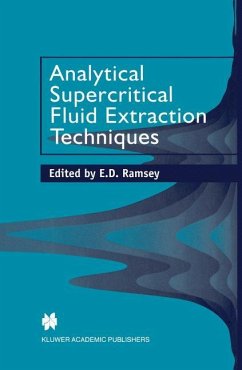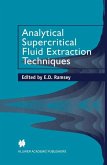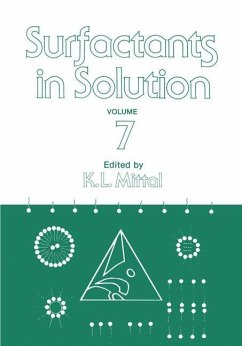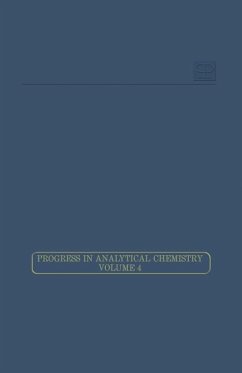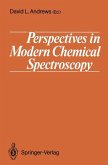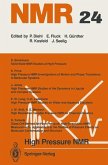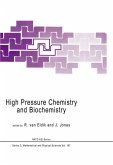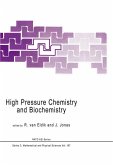Analytical Supercritical Fluid Extraction Techniques
Herausgegeben:Ramsey, E. D.
Analytical Supercritical Fluid Extraction Techniques
Herausgegeben:Ramsey, E. D.
- Broschiertes Buch
- Merkliste
- Auf die Merkliste
- Bewerten Bewerten
- Teilen
- Produkt teilen
- Produkterinnerung
- Produkterinnerung
During the past decade supercritical fluid extration (SFE) has attracted considerable attention as a sample preparation procedure in analytical chemistry. The successful implementation of this technique can lead to improved sample throughput, more efficient recovery of analytes, cleaner extracts, economic replacement of halogenated solvents and a high level of automation, compared to conventional sample preparation procedures. This book provides an overview of basic principles of SFE as well as in-depth reviews of both on- and off-line SFE methods. The on-line coupling of SFE with both…mehr
Andere Kunden interessierten sich auch für
![Analytical Supercritical Fluid Extraction Techniques Analytical Supercritical Fluid Extraction Techniques]() RamseyAnalytical Supercritical Fluid Extraction Techniques161,99 €
RamseyAnalytical Supercritical Fluid Extraction Techniques161,99 €![Surfactants in Solution Surfactants in Solution]() Surfactants in Solution39,99 €
Surfactants in Solution39,99 €![Computers in Analytical Chemistry Computers in Analytical Chemistry]() Computers in Analytical Chemistry41,99 €
Computers in Analytical Chemistry41,99 €![Perspectives in Modern Chemical Spectroscopy Perspectives in Modern Chemical Spectroscopy]() Perspectives in Modern Chemical Spectroscopy40,99 €
Perspectives in Modern Chemical Spectroscopy40,99 €![High Pressure NMR High Pressure NMR]() High Pressure NMR81,99 €
High Pressure NMR81,99 €![High Pressure Chemistry and Biochemistry High Pressure Chemistry and Biochemistry]() High Pressure Chemistry and Biochemistry242,99 €
High Pressure Chemistry and Biochemistry242,99 €![High Pressure Chemistry and Biochemistry High Pressure Chemistry and Biochemistry]() R. van Eldik / Jiri Jonas (Hgg.)High Pressure Chemistry and Biochemistry242,99 €
R. van Eldik / Jiri Jonas (Hgg.)High Pressure Chemistry and Biochemistry242,99 €-
-
-
During the past decade supercritical fluid extration (SFE) has attracted considerable attention as a sample preparation procedure in analytical chemistry. The successful implementation of this technique can lead to improved sample throughput, more efficient recovery of analytes, cleaner extracts, economic replacement of halogenated solvents and a high level of automation, compared to conventional sample preparation procedures.
This book provides an overview of basic principles of SFE as well as in-depth reviews of both on- and off-line SFE methods. The on-line coupling of SFE with both chromatographic and spectroscopics techniques has been the subject of a great deal of research effort and is dealt with in detail. Newer developments, such as off-line SFE of solid and liquid matrices, are starting to attract a great deal of interest, and the coverage of these areas will prove of particular value to the analytical chemist. The international team of authors has illustrated these topics with many `state-of-the-art' applications, and each chapter provides a comprehensive list of references. For the convenience of the reader, an appendix which contains pressure conversion scales and supercritical fluid carbon dioxide density tables appears at the end of the book.
The volume's extensive coverage of both on-line and off-line extraction will be particularly useful to analytical chemists, in a wide range of environments, seeking to develop high quality, simple and robust SFE methods.
This book provides an overview of basic principles of SFE as well as in-depth reviews of both on- and off-line SFE methods. The on-line coupling of SFE with both chromatographic and spectroscopics techniques has been the subject of a great deal of research effort and is dealt with in detail. Newer developments, such as off-line SFE of solid and liquid matrices, are starting to attract a great deal of interest, and the coverage of these areas will prove of particular value to the analytical chemist. The international team of authors has illustrated these topics with many `state-of-the-art' applications, and each chapter provides a comprehensive list of references. For the convenience of the reader, an appendix which contains pressure conversion scales and supercritical fluid carbon dioxide density tables appears at the end of the book.
The volume's extensive coverage of both on-line and off-line extraction will be particularly useful to analytical chemists, in a wide range of environments, seeking to develop high quality, simple and robust SFE methods.
Produktdetails
- Produktdetails
- Verlag: Springer / Springer Netherlands
- Artikelnr. des Verlages: 978-94-010-6076-9
- Softcover reprint of the original 1st ed. 1998
- Seitenzahl: 456
- Erscheinungstermin: 5. Oktober 2012
- Englisch
- Abmessung: 235mm x 155mm x 25mm
- Gewicht: 686g
- ISBN-13: 9789401060769
- ISBN-10: 9401060762
- Artikelnr.: 37479539
- Herstellerkennzeichnung Die Herstellerinformationen sind derzeit nicht verfügbar.
- Verlag: Springer / Springer Netherlands
- Artikelnr. des Verlages: 978-94-010-6076-9
- Softcover reprint of the original 1st ed. 1998
- Seitenzahl: 456
- Erscheinungstermin: 5. Oktober 2012
- Englisch
- Abmessung: 235mm x 155mm x 25mm
- Gewicht: 686g
- ISBN-13: 9789401060769
- ISBN-10: 9401060762
- Artikelnr.: 37479539
- Herstellerkennzeichnung Die Herstellerinformationen sind derzeit nicht verfügbar.
1 Introduction to supercritical fluid extraction in analytical science.- 1.1 Introduction.- 1.2 Pure and modified supercritical fluids.- 1.3 Density of a supercritical fluid.- 1.4 Viscosity and diffusion.- 1.5 Solubility in a supercritical fluid.- 1.6 Factors affecting supercritical fluid extraction.- 1.7 Modelling of supercritical fluid extraction.- 1.8 Continuous dynamic supercritical fluid extraction controlled by diffusion.- 1.9 Continuous dynamic supercritical fluid extraction controlled by both diffusion and solvation.- 1.10 Continuous dynamic supercritical fluid extraction controlled by diffusion, solvation and matrix effects.- 1.11 Extrapolation of continuous extraction results.- 1.12 Derivations and discussions of model equations.- 1.12.1 Extraction from a sphere controlled by transport only.- 1.12.2 Extraction from a film controlled by transport only.- 1.12.3 Extraction from a film, with non-uniform concentration distribution, controlled by transport only.- 1.12.4 Extraction from a sphere controlled by transport and solvation.- 1.12.5 Extraction from a film controlled by transport and solvation.- 1.12.6 Extraction from a sphere controlled by transport, solvation and matrix effects.- 1.12.7 Extraction from a sphere controlled by transport, solvation and matrix effects, with non-uniform initial concentration.- 1.12.8 Extrapolation using the models.- References.- 2 Supercritical fluid extraction instrumentation.- 2.1 Introduction.- 2.2 Analyte and matrix.- 2.3 Modifier addition.- 2.4 On-line and off-line supercritical fluid extraction.- 2.5 Supercritical fluid delivery.- 2.5.1 Syringe pumps.- 2.5.2 Reciprocating piston pumps.- 2.5.3 Pneumatic amplifier pumps.- 2.6 Extraction vessels.- 2.7 Supercritical fluid extraction flow-control devices and restrictors.- 2.7.1Fixed-flow restrictors.- 2.7.2 Variable-flow restrictors.- 2.7.3 Summary.- 2.8 Supercritical fluid extraction collection modes.- 2.8.1 Off-line liquid trapping.- 2.8.2 Off-line solid phase collection.- 2.8.3 Off-line solventless collection.- 2.8.4 On-line collection modes.- 2.8.5 Summary.- 2.9 Automation of supercritical fluid extraction.- 2.9.1 Parallel supercritical fluid extraction systems.- 2.9.2 Sequential supercritical fluid extraction systems.- 2.9.3 Summary.- 2.10 Future developments.- 2.10.1 Supercritical fluid extraction in the production environment.- 2.10.2 Field portable systems.- 2.10.3 Pressurized fluid extraction.- References.- 3 Off-line supercritical fluid extraction for solid matrices.- 3.1 Introduction.- 3.1.1 Sample preparation for supercritical fluid extraction.- 3.1.2In situsupercritical fluid derivatization extraction schemes.- 3.1.3 In-line supercritical fluid extraction cleanup procedures.- 3.2 Experimental parameters of supercritical fluid extraction.- 3.2.1 Type of fluid.- 3.2.2 Effect of density.- 3.2.3 Selection of supercritical fluid extraction temperature.- 3.2.4 Selection of organic modifier.- 3.3 Extract collection.- 3.3.1 Extract trapping using solvents.- 3.3.2 Extract trapping using solid-phase sorbents.- 3.4 Mathematical models used for optimizing supercritical fluid extraction parameters.- 3.4.1 Supercritical fluid extraction kinetic models.- 3.4.2 Strategies for the optimization of supercritical fluid extraction variables.- References.- 4 Supercritical fluid extraction strategies of liquid-based matrices.- 4.1 Introduction.- 4.2 General considerations.- 4.2.1 Vessels for direct liquid supercritical fluid extraction.- 4.2.2 Vessels for indirect liquid supercritical fluid extraction.- 4.2.3 Liquid supercritical fluid extraction vessel safety considerations.- 4.2.4 Selection of support media for indirect liquid supercritical fluid extraction.- 4.2.5 Restrictors and analyte traps for direct and indirect liquid supercritical fluid extraction.- 4.3 Procedures involving pH control and use of additives to improve supercritical fluid extraction efficiencies of analytes from aqueous samples.- 4.4 Aqueous sample derivatisation procedures.- 4.5 Supercritical fluid extraction of metal ions from aqueous media.- 4.6 Supercritical fluid extraction of analytes from enzymic reactions.- 4.7 Inverse supercritical fluid extraction.- 4.8 Selected liquid supercritical fluid extraction applications.- 4.9 Conclusions.- References.- 5 Supercritical fluid extraction coupled on-line with gas chromatography.- 5.1 Introduction.- 5.2 Techniques for coupling supercritical fluid extraction with gas chromatography.- 5.3 External trapping of analytes.- 5.4 Internal accumulation of analytes.- 5.5 Construction of supercritical fluid extraction-gas chromatography instrumentation.- 5.6 Optimisation of supercritical fluid extraction-gas chromatography.- 5.6.1 Extraction flow rate.- 5.6.2 Column trapping temperature.- 5.6.3 Column stationary phase thickness.- 5.7 Quantitative supercritical fluid extraction-gas chromatography.- 5.8 Optimisation of extraction conditions for supercritical fluid extraction-gas chromatography.- 5.9 Supercritical fluid extraction-gas chromatography applications.- 5.9.1 Environmental samples.- 5.9.2 Plant and plant-derived samples.- 5.10 Conclusions.- References.- 6 Coupled supercritical fluid extraction-capillary supercritical fluid chromatography.- 6.1 Introduction.- 6.2 Samples for which supercritical fluid extraction-capillary supercritical fluid chromatography is applicable.- 6.3 Influenceof the sample matrix.- 6.4 Instrumentation.- 6.5 Extraction vessels.- 6.6 Supercritical fluid extraction-capillary supercritical fluid chromatography interface.- 6.6.1 Aliquot sampling.- 6.6.2 Trapping of analytes.- 6.7 Trapping procedures.- 6.7.1 Trapping on uncoated fused-silica retention gaps.- 6.7.2 Trapping on coated fused-silica retaining pre-columns.- 6.7.3 Trapping on sorbent traps.- 6.8 Use of modifiers and solvent venting.- 6.9 Supercritical fluid extraction as a sample introduction technique.- 6.10 Optimisation of conditions for supercritical fluid extraction-capillary supercritical fluid chromatography.- 6.11 Selected applications of supercritical fluid extraction-capillary supercritical fluid chromatography.- 6.12 Conclusions.- References.- 7 Supercritical fluid extraction coupled to packed column supercritical fluid chromatography.- 7.1 Introduction.- 7.2 Supercritical fluid chromatography: packed versus capillary columns.- 7.2.1 Efficiency.- 7.2.2 Selectivity.- 7.2.3 Sample capacity.- 7.2.4 Detectors.- 7.2.5 Analysis times.- 7.2.6 Restrictors.- 7.2.7 Temperature.- 7.3 Supercritical fluid extraction coupled to packed column supercritical fluid chromatography.- 7.3.1 Supercritical fluid mobile phase.- 7.3.2 Supercritical fluid extraction.- 7.3.3 Supercritical fluid chromatography.- 7.3.4 Supercritical fluid extraction coupled to packed column supercritical fluid chromatography.- 7.4 Instrumental aspects.- 7.4.1 Back pressure regulators.- 7.4.2 Extraction vessels.- 7.4.3 On-line analyte trapping and concentration.- 7.4.4 On-line sample introduction.- 7.4.5 Columns.- 7.4.6 Detectors.- 7.4.7 Fraction collection.- 7.5 Selected applications.- 7.6 Future prospects.- Acknowledgement.- References.- 8 Supercritical fluid extraction for off-line and on-linehigh-performance liquid chromatographic analysis.- 8.1 Introduction.- 8.2 Supercritical fluid extraction-high-performance liquid chromatography.- 8.3 Supercritical fluid extraction followed by off-line high-performance liquid chromatography analysis.- 8.4 On-line supercritical fluid extraction-high-performance liquid chromatography sample preparation techniques.- 8.5 Selected analyses performed using on-line supercritical fluid extraction-high-performance liquid chromatography.- 8.6 Conclusions.- References.- 9 Supercritical fluid extraction coupled on-line with mass spectrometry and spectroscopic techniques.- 9.1 Introduction.- 9.2 On-line supercritical fluid extraction-Fourier transform infra-red spectroscopy.- 9.2.1 Flow cell supercritical fluid extraction-Fourier transform infra-red spectroscopy.- 9.2.2 Stop-flow supercritical fluid extraction-Fourier transform infra-red spectroscopy.- 9.2.3 On-line supercritical fluid extraction-supercritical fluid chromatography-Fourier transform infra-red spectroscopy and supercritical fluid extraction-capillary supercritical fluid chromatography-Fourier transform infra-red spectroscopy.- 9.3 On-line supercritical fluid extraction-nuclear magnetic resonance spectroscopy.- 9.4 On-line supercritical fluid extraction-gas chromatography-mass spectrometry.- 9.5 On-line supercritical fluid extraction-capillary supercritical fluid chromatography-mass spectrometry.- 9.6 On-line supercritical fluid extraction-packed column supercritical fluid chromatography-mass spectrometry.- 9.7 On-line supercritical fluid extraction-liquid chromatography-mass spectrometry.- 9.8 Conclusions.- References.- 10 Modern alternatives to supercritical fluid extraction.- 10.1 Introduction.- 10.2 Microwave-assistedextraction.- 10.2.1 Theory of microwave heating.- 10.2.2 Instrumentation.- 10.2.3 Selection of solvent and extraction conditions.- 10.2.4 Applications of microwave-assisted extraction.- 10.3 Accelerated solvent extraction.- 10.3.1 Theoretical considerations.- 10.3.2 Instrumentation.- 10.3.3 Applications: environmental matrices.- 10.3.4 Applications: food matrices.- 10.3.5 Applications: polymeric matrices.- 10.4 Conclusions.- References.- Matrix index.- Analyte index.
1 Introduction to supercritical fluid extraction in analytical science.- 1.1 Introduction.- 1.2 Pure and modified supercritical fluids.- 1.3 Density of a supercritical fluid.- 1.4 Viscosity and diffusion.- 1.5 Solubility in a supercritical fluid.- 1.6 Factors affecting supercritical fluid extraction.- 1.7 Modelling of supercritical fluid extraction.- 1.8 Continuous dynamic supercritical fluid extraction controlled by diffusion.- 1.9 Continuous dynamic supercritical fluid extraction controlled by both diffusion and solvation.- 1.10 Continuous dynamic supercritical fluid extraction controlled by diffusion, solvation and matrix effects.- 1.11 Extrapolation of continuous extraction results.- 1.12 Derivations and discussions of model equations.- 1.12.1 Extraction from a sphere controlled by transport only.- 1.12.2 Extraction from a film controlled by transport only.- 1.12.3 Extraction from a film, with non-uniform concentration distribution, controlled by transport only.- 1.12.4 Extraction from a sphere controlled by transport and solvation.- 1.12.5 Extraction from a film controlled by transport and solvation.- 1.12.6 Extraction from a sphere controlled by transport, solvation and matrix effects.- 1.12.7 Extraction from a sphere controlled by transport, solvation and matrix effects, with non-uniform initial concentration.- 1.12.8 Extrapolation using the models.- References.- 2 Supercritical fluid extraction instrumentation.- 2.1 Introduction.- 2.2 Analyte and matrix.- 2.3 Modifier addition.- 2.4 On-line and off-line supercritical fluid extraction.- 2.5 Supercritical fluid delivery.- 2.5.1 Syringe pumps.- 2.5.2 Reciprocating piston pumps.- 2.5.3 Pneumatic amplifier pumps.- 2.6 Extraction vessels.- 2.7 Supercritical fluid extraction flow-control devices and restrictors.- 2.7.1Fixed-flow restrictors.- 2.7.2 Variable-flow restrictors.- 2.7.3 Summary.- 2.8 Supercritical fluid extraction collection modes.- 2.8.1 Off-line liquid trapping.- 2.8.2 Off-line solid phase collection.- 2.8.3 Off-line solventless collection.- 2.8.4 On-line collection modes.- 2.8.5 Summary.- 2.9 Automation of supercritical fluid extraction.- 2.9.1 Parallel supercritical fluid extraction systems.- 2.9.2 Sequential supercritical fluid extraction systems.- 2.9.3 Summary.- 2.10 Future developments.- 2.10.1 Supercritical fluid extraction in the production environment.- 2.10.2 Field portable systems.- 2.10.3 Pressurized fluid extraction.- References.- 3 Off-line supercritical fluid extraction for solid matrices.- 3.1 Introduction.- 3.1.1 Sample preparation for supercritical fluid extraction.- 3.1.2In situsupercritical fluid derivatization extraction schemes.- 3.1.3 In-line supercritical fluid extraction cleanup procedures.- 3.2 Experimental parameters of supercritical fluid extraction.- 3.2.1 Type of fluid.- 3.2.2 Effect of density.- 3.2.3 Selection of supercritical fluid extraction temperature.- 3.2.4 Selection of organic modifier.- 3.3 Extract collection.- 3.3.1 Extract trapping using solvents.- 3.3.2 Extract trapping using solid-phase sorbents.- 3.4 Mathematical models used for optimizing supercritical fluid extraction parameters.- 3.4.1 Supercritical fluid extraction kinetic models.- 3.4.2 Strategies for the optimization of supercritical fluid extraction variables.- References.- 4 Supercritical fluid extraction strategies of liquid-based matrices.- 4.1 Introduction.- 4.2 General considerations.- 4.2.1 Vessels for direct liquid supercritical fluid extraction.- 4.2.2 Vessels for indirect liquid supercritical fluid extraction.- 4.2.3 Liquid supercritical fluid extraction vessel safety considerations.- 4.2.4 Selection of support media for indirect liquid supercritical fluid extraction.- 4.2.5 Restrictors and analyte traps for direct and indirect liquid supercritical fluid extraction.- 4.3 Procedures involving pH control and use of additives to improve supercritical fluid extraction efficiencies of analytes from aqueous samples.- 4.4 Aqueous sample derivatisation procedures.- 4.5 Supercritical fluid extraction of metal ions from aqueous media.- 4.6 Supercritical fluid extraction of analytes from enzymic reactions.- 4.7 Inverse supercritical fluid extraction.- 4.8 Selected liquid supercritical fluid extraction applications.- 4.9 Conclusions.- References.- 5 Supercritical fluid extraction coupled on-line with gas chromatography.- 5.1 Introduction.- 5.2 Techniques for coupling supercritical fluid extraction with gas chromatography.- 5.3 External trapping of analytes.- 5.4 Internal accumulation of analytes.- 5.5 Construction of supercritical fluid extraction-gas chromatography instrumentation.- 5.6 Optimisation of supercritical fluid extraction-gas chromatography.- 5.6.1 Extraction flow rate.- 5.6.2 Column trapping temperature.- 5.6.3 Column stationary phase thickness.- 5.7 Quantitative supercritical fluid extraction-gas chromatography.- 5.8 Optimisation of extraction conditions for supercritical fluid extraction-gas chromatography.- 5.9 Supercritical fluid extraction-gas chromatography applications.- 5.9.1 Environmental samples.- 5.9.2 Plant and plant-derived samples.- 5.10 Conclusions.- References.- 6 Coupled supercritical fluid extraction-capillary supercritical fluid chromatography.- 6.1 Introduction.- 6.2 Samples for which supercritical fluid extraction-capillary supercritical fluid chromatography is applicable.- 6.3 Influenceof the sample matrix.- 6.4 Instrumentation.- 6.5 Extraction vessels.- 6.6 Supercritical fluid extraction-capillary supercritical fluid chromatography interface.- 6.6.1 Aliquot sampling.- 6.6.2 Trapping of analytes.- 6.7 Trapping procedures.- 6.7.1 Trapping on uncoated fused-silica retention gaps.- 6.7.2 Trapping on coated fused-silica retaining pre-columns.- 6.7.3 Trapping on sorbent traps.- 6.8 Use of modifiers and solvent venting.- 6.9 Supercritical fluid extraction as a sample introduction technique.- 6.10 Optimisation of conditions for supercritical fluid extraction-capillary supercritical fluid chromatography.- 6.11 Selected applications of supercritical fluid extraction-capillary supercritical fluid chromatography.- 6.12 Conclusions.- References.- 7 Supercritical fluid extraction coupled to packed column supercritical fluid chromatography.- 7.1 Introduction.- 7.2 Supercritical fluid chromatography: packed versus capillary columns.- 7.2.1 Efficiency.- 7.2.2 Selectivity.- 7.2.3 Sample capacity.- 7.2.4 Detectors.- 7.2.5 Analysis times.- 7.2.6 Restrictors.- 7.2.7 Temperature.- 7.3 Supercritical fluid extraction coupled to packed column supercritical fluid chromatography.- 7.3.1 Supercritical fluid mobile phase.- 7.3.2 Supercritical fluid extraction.- 7.3.3 Supercritical fluid chromatography.- 7.3.4 Supercritical fluid extraction coupled to packed column supercritical fluid chromatography.- 7.4 Instrumental aspects.- 7.4.1 Back pressure regulators.- 7.4.2 Extraction vessels.- 7.4.3 On-line analyte trapping and concentration.- 7.4.4 On-line sample introduction.- 7.4.5 Columns.- 7.4.6 Detectors.- 7.4.7 Fraction collection.- 7.5 Selected applications.- 7.6 Future prospects.- Acknowledgement.- References.- 8 Supercritical fluid extraction for off-line and on-linehigh-performance liquid chromatographic analysis.- 8.1 Introduction.- 8.2 Supercritical fluid extraction-high-performance liquid chromatography.- 8.3 Supercritical fluid extraction followed by off-line high-performance liquid chromatography analysis.- 8.4 On-line supercritical fluid extraction-high-performance liquid chromatography sample preparation techniques.- 8.5 Selected analyses performed using on-line supercritical fluid extraction-high-performance liquid chromatography.- 8.6 Conclusions.- References.- 9 Supercritical fluid extraction coupled on-line with mass spectrometry and spectroscopic techniques.- 9.1 Introduction.- 9.2 On-line supercritical fluid extraction-Fourier transform infra-red spectroscopy.- 9.2.1 Flow cell supercritical fluid extraction-Fourier transform infra-red spectroscopy.- 9.2.2 Stop-flow supercritical fluid extraction-Fourier transform infra-red spectroscopy.- 9.2.3 On-line supercritical fluid extraction-supercritical fluid chromatography-Fourier transform infra-red spectroscopy and supercritical fluid extraction-capillary supercritical fluid chromatography-Fourier transform infra-red spectroscopy.- 9.3 On-line supercritical fluid extraction-nuclear magnetic resonance spectroscopy.- 9.4 On-line supercritical fluid extraction-gas chromatography-mass spectrometry.- 9.5 On-line supercritical fluid extraction-capillary supercritical fluid chromatography-mass spectrometry.- 9.6 On-line supercritical fluid extraction-packed column supercritical fluid chromatography-mass spectrometry.- 9.7 On-line supercritical fluid extraction-liquid chromatography-mass spectrometry.- 9.8 Conclusions.- References.- 10 Modern alternatives to supercritical fluid extraction.- 10.1 Introduction.- 10.2 Microwave-assistedextraction.- 10.2.1 Theory of microwave heating.- 10.2.2 Instrumentation.- 10.2.3 Selection of solvent and extraction conditions.- 10.2.4 Applications of microwave-assisted extraction.- 10.3 Accelerated solvent extraction.- 10.3.1 Theoretical considerations.- 10.3.2 Instrumentation.- 10.3.3 Applications: environmental matrices.- 10.3.4 Applications: food matrices.- 10.3.5 Applications: polymeric matrices.- 10.4 Conclusions.- References.- Matrix index.- Analyte index.

